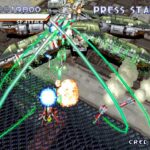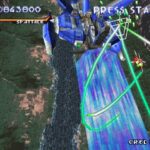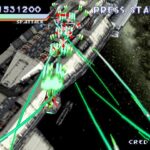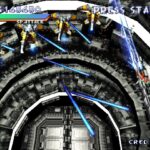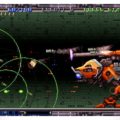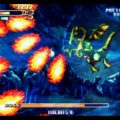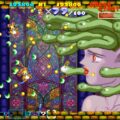Developer: Taito Publisher: Working Designs Release: 09/97 Genre: Shooter
Sega’s surprise Saturn launch in the US meant new releases was slow in the early months. Galactic Attack was an early bright spot in that period and managed to stand out in a crowded shooter field. RayStorm takes everything that game did and dials it up to 11. But we almost missed out on this classic. By the time it came to the west in 1997 the shooter market was already in decline. Kudos to Working Designs for taking a chance on a fantastic little gem that is worth every penny.
RayStorm offers a choice between two ships that are radically different mechanically. The R-Gray 1 has a spread gun as its default shot and can lock on to a maximum of eight targets. The R-Gray 2 features a cutting laser that pierces targets but has a narrow beam. This unit can lock on to 16 (!) targets. Its lasers are weaker than the R-Gray 1 but they chain to the closest targets. There is nuance in using the R-Gray 2 but it is by far my favorite. By concentrating your lock-on lasers to one target you can activate a hyper laser that differs per ship. While devastating you have to weigh the risk/reward of focusing on one target. The added benefit of doing so means filling up the special attack meter for one big burst attack that also grants temporary invincibility.
I’ve always admired Taito’s ability to do a lot with very little. Where that works against it in the Darius series here the meager weapon setup is not a detriment. There is a lot of nuance to how you manage the two primary weapons. The automatic lock-on option sounds enticing at first but it lacks the ability to prioritize targets. For novices it is an excellent choice. Veterans will prefer the manual option even though it requires more work. Being able to manually select your targets or to focus on a weak point when necessary is a skill that will carry you far, not to mention it feels more satisfying. It is also the only way to attain high scores do to the way the scoring system works. So while RayStorm is mechanically simple it feels a lot better to play than more “advanced” shooters.
The sheer spectacle on display in RayStorm is one of its best elements. Now that the game is fully 3d it can convey a sense of depth and scale that its predecessor could not. The battle against the space armada in stage four is epic as you dart and weave between massive ships and waves of enemies. It culminates in a battle against a capital ship that calls to mind R-Type. It’s the stuff we dreamed of during the 16-bit era fully realized. Although the game no longer transitions smoothly from one level to the next there is a journey at hand. You start on Earth before taking to the stars and finally invading the enemy base. The variety in set pieces is incredible and while I miss the way Galactic Attack logically progressed it isn’t even a complaint.
The tilted perspective allows for a wider playing field full of enemies. I miss the multi-layered planes of the first game but this is almost as good. Since this is not a completely vertical shooter anymore you no longer need to be directly on top of enemies to target them. This allows for easier lock-on targeting and score multipliers. Sadly you do not get extra lives or continues for your points which go against the tradition of the genre. It is a bitter pill to swallow as RayStorm is one of the harder shooters out there.
RayStorm is a difficult game. Regardless of power-ups the game goes from 0-100 as soon as each level starts. While the spectacle is nice it is easy to get lost and take cheap hits. I can’t count the number of times a stray bullet hit me and it happens to often. Prepare for a war of attrition as the boss battles take a while. Working Designs made it more difficult for the US in a few ways. The default difficulty is 2 steps higher than its Japanese counterpart. Credits are also limited which sucks. You can adjust the difficulty per level and starting lives but anything under normal forces the game into Training Mode which ends after stage four. On one hand I can see why; the rental market was huge and shooters were prime targets. Although I understand it that doesn’t mean I have to like it.
To make up for the increased difficulty Working Designs went to town loading RayStorm with extras. The most prominent is Extra Mode, which heavily remixes the game, giving bosses new attacks, the levels take place at different times of day, and a choice of a remixed soundtrack. If you can complete this mode 13 ships mode becomes available. Here you are challenged to complete the game using just 13 lives. For every two lives lost you must choose a new ship with preset options like automatic targeting. The real star of this mode is the new ship you can use, the R-Gray 0. There is also a stage select after you beat the game which is good for practicing to get better alongside the training mode. Altogether these are a solid set of extras and give the game a lot of replay value.
In Closing
RayStorm is a fantastic game all around and an excellent localization choice from Working Designs. While difficult the challenge is not insurmountable and has plenty of reasons to revisit it if you are not into chasing high scores. The PlayStation had a respectable lineup of shooters in the US and I think RayStorm is easily one of its best. With its numerous re-releases it also easily accessible as well.

